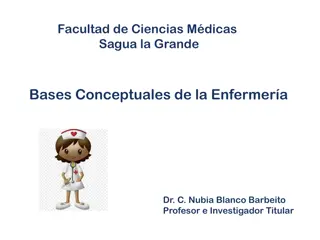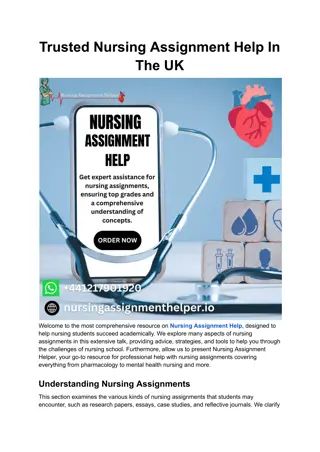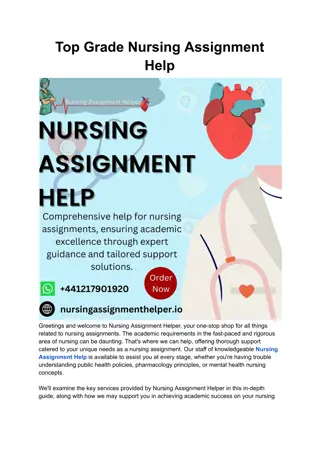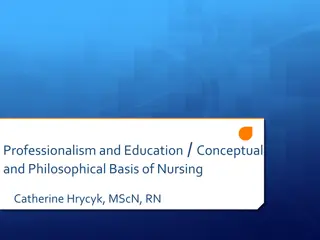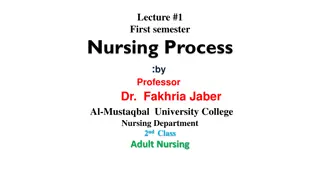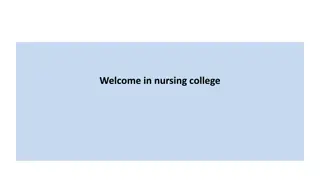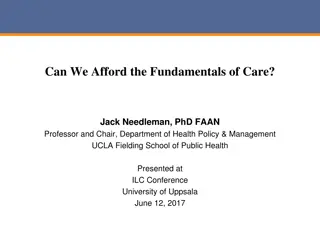Nursing Process: Assessment and Data Collection
The nursing process involves the systematic problem-solving approach of assessing, diagnosing, planning, implementing, and evaluating patient care. Assessment is the initial step, where data is collected from primary and secondary resources to gather subjective and objective information. This data must be complete, accurate, and relevant to provide a comprehensive patient-centered care framework. Understanding the characteristics of data types is vital in ensuring effective care delivery.
Download Presentation

Please find below an Image/Link to download the presentation.
The content on the website is provided AS IS for your information and personal use only. It may not be sold, licensed, or shared on other websites without obtaining consent from the author.If you encounter any issues during the download, it is possible that the publisher has removed the file from their server.
You are allowed to download the files provided on this website for personal or commercial use, subject to the condition that they are used lawfully. All files are the property of their respective owners.
The content on the website is provided AS IS for your information and personal use only. It may not be sold, licensed, or shared on other websites without obtaining consent from the author.
E N D
Presentation Transcript
Nursing Department Medical-Surgical Nursing For second Year Health and Nursing Process Lec. 1 Instructor: PhD.Sc.N. Mahdi Hamzah AL- Taee
Health Definition of the health according to WHO: Is a state complete of physical, mental, and social well-being . Another define is equilibrium between wellness and illness .
The Nursing Process Definition: Nursing used to identify, prevent ,and treat actual and potential health problem The goal of nursing process: Identify patient health care status. Actual and potential health problem. Establish plan to meet the need. Nursing process process: is a systematic problem-solving approach
Stages of The Nursing Process The nursing process is often remembered by the acronym ADPIE: Assessment Nursing Diagnosis Planning Implementation Evaluation
Characteristics of the Nursing Process Provide the framework of care. Its patients center. Adapted of problem solving technique. Its Planned-organized and systematic. Its cyclic and dynamic.
1.Assessment: Definition: Assessment collect and organized data . data collection mean gathering information about the patient. Assessment: is the first step of nursing process include
Resources of date 1.Primary resource: Take information from the patient during patient interview. 2.Secondary resource - Family - Nursing record. - Medical record. - Examination
Type of data Subjective data: it is information perceived only by the affected person (patient)ex: pain. Objective data: it is observable and measurable data that can be seen, heard or felt by someone other than the person(nurse or health workers) experiencing them ex: elevated body temperature.
Characteristic of data Complete Accurate Relevant
2.Nursing Diagnosis: An actual or potential health problem that is focuses upon the human response of an individual or group writing diagnostic statements for actual nursing diagnosis we should use the "PES "system to describe the diagnosis. We write three part statement which include the following: 1.The 2 2. .Its 3 3. .The The problem Its cause The signs problem (p) cause or or etiology signs and (p) etiology (E) and symptoms (E) symptoms (S) (S)
NANDA: NANDA (North America Nursing Diagnosis Associate ): Is professional organization of nurses standardized nursing diagnosis that was officially founded in 1982 . Steps Problem Of Pt. Related To Medical Diagnosis Definition Defining Characteristics (signs and symptoms) Expected Outcome (plan) Interventions And Rationales Documentation. Steps of of research research for for the the problem problem
Purpose: Nursing diagnosis : provides the basis for selection of nursing interventions to achieve outcomes for which the nurse is accountable. Diagnosis is the second phase the nursing process. Analyze date. Identify health problem and risk. Identify the characteristic of nursing problem. State nursing diagnosis in concise way and precisely. Diagnosis is the second phase the nursing process.
Difference between nursing and medical diagnosis. Nursing diagnosis actual or potential response to a health problem that a nurse is licensed and competent to treat i.e.: impaired skin integrity, risk for infection, etc. Medical disease i.e.: diabetic mellitus, give insulin, caloric diet and moderate exercise. Nursing diagnosis : statement used to describe the clients Medical diagnosis diagnosis :physicians clinical judgment of the
3.Planning Definition: Planning involves decision making. Planning process Prioritize problem. Formulate goal. Select nursing intervention Write nursing order. Record and modify. Planning : is systematic phase of nursing process that
4. Implementation Definition: Implementation nursing plan into action. Implementation process Reassessing the patient. Determine the nurse need for assistance. Implementing. Supervising. Document the action. Implementation : is the phase in which the nurse puts the
5.Evaluation Definition: Determine the patient progress to ward goals achievement and effectives of the nursing care plan. Example: The goal met. The goal not met. The goal partially met.
Case study Mrs is elevated, productive cough, rapid respiration with difficulty. 1. Assessment v\s are temperature 39.1 C Pulse 92 b\m Respiration rate 28 b\m and Blood pressure 122\80 mmhg Observe that mrs.A is dry skin, her cheeks are flushed she is experience of chill. On chest, auscultation reveals respiratory crackles. Mrs. . (A) (A) 27 years old admitted to hospital, married, the temperature
Cont., 2 2. .Diagnosis Ineffective breathing pattern related to accumulation of secretion as manifested by productive cough, rapid respiration with difficult. 3. Planning Restore effectiveness breathing pattern intervention: deep breathing exercise. Increase fluid intake bronchodilator medication. Diagnosis
Cont., 4 4. . Implementation Mrs. A agree to practice. Deep breathing exercise. Increase the fluid in take Take bronchodilator medication. 5. Evaluation The goal not met the nurse detects failure of the client to breath normally the plan modify to reach normal breathing and then Re Implementation Re- -evaluation evaluation
Thank You 20



